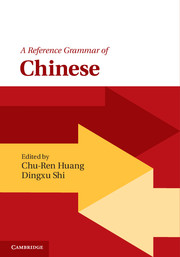Book contents
- Frontmatter
- Dedication
- Contents
- List of figures
- List of tables
- List of contributors
- Preface
- Acknowledgements
- English–Chinese term list
- Chinese–English term list
- 1 Preliminaries
- 2 Syntactic overview
- 3 Lexical word formation
- 4 Verbs and verb phrases
- 5 Aspectual system
- 6 Negation
- 7 Classifiers
- 8 Nouns and nominal phrases
- 9 Relative constructions
- 10 Adjectives and adjective phrases
- 11 Comparison
- 12 Adverbs
- 13 Prepositions and preposition phrases
- 14 Sentence types
- 15 Major non-canonical clause types: ba and bei
- 16 Deixis and anaphora
- 17 Information structure
- Appendix: Punctuation
- Bibliography
- Index
2 - Syntactic overview
Published online by Cambridge University Press: 05 March 2016
- Frontmatter
- Dedication
- Contents
- List of figures
- List of tables
- List of contributors
- Preface
- Acknowledgements
- English–Chinese term list
- Chinese–English term list
- 1 Preliminaries
- 2 Syntactic overview
- 3 Lexical word formation
- 4 Verbs and verb phrases
- 5 Aspectual system
- 6 Negation
- 7 Classifiers
- 8 Nouns and nominal phrases
- 9 Relative constructions
- 10 Adjectives and adjective phrases
- 11 Comparison
- 12 Adverbs
- 13 Prepositions and preposition phrases
- 14 Sentence types
- 15 Major non-canonical clause types: ba and bei
- 16 Deixis and anaphora
- 17 Information structure
- Appendix: Punctuation
- Bibliography
- Index
Summary
The description of Chinese grammar in this book is based on the following principles: sentences are composed of parts, which may themselves have parts; sentence parts belong to a limited range of types; and different parts of a sentence have specific roles or functions within the larger parts to which they belong. This description is divided into two major components: morphology and syntax. The former deals with how words are put together, while the latter deals with how words are combined to make phrases, clauses, and then sentences.
Morphemes, words, and word classes
A morpheme is the smallest unit with meaning. A word is the smallest unit that has independent functions in syntax, while a sentence is the largest syntactic unit. The main constituent of a sentence is a clause, or several coordinated clauses, which represents a proposition and usually appears in the form of a subject–predicate construction. The other constituents in a sentence are final particles, which are attached to the end of the main clause to form a sentence while providing additional and necessary information. A clause can function as part of another clause, namely, as a subordinate clause. The clause that is not contained in any other clause is the main clause. The subject, predicate, and their modifiers are phrases, while the object inside the predicate is also a phrase. A phrase has one or more words as its immediate parts and one of the parts is its head, which determines its syntactic status. For example, a verb phrase has a verb as its head and an adjective phrase has an adjective as its head.
Morphemes
Most native Chinese morphemes are monosyllabic, like those in [1a]. Native disyllabic morphemes, such as those in [1b], are few in number and a large portion of them have either a consonant alliteration, such as 蜘蛛 zhi1zhu1 ‘spider,’ or a vowel rhyme, such as 迷离 mi2li2 ‘bewildered.’ Some disyllabic morphemes are borrowed from other languages, such as those in [1c]. Multisyllabic morphemes are predominantly loan items, such as those in [1d].
[1] a. 猪 zhu1 ‘pig,’ 山 shan1 ‘mountain,’ 铁 tie3 ‘iron,’ 花 hua1 ‘flower,’ 跑 pao3 ‘run,’ 哭 ku1 ‘cry,’ 扔 reng1 ‘throw,’ 杀 sha1 ‘kill,’ 追 zhui1 ‘chase,’ 好 hao3 ‘good,’ 旧 jiu4 ‘old,’ 脏 zang1 ‘dirty,’ 臭 chou4 ‘stinking,’ 大 da4 ‘big’
- Type
- Chapter
- Information
- A Reference Grammar of Chinese , pp. 14 - 66Publisher: Cambridge University PressPrint publication year: 2016
- 1
- Cited by



